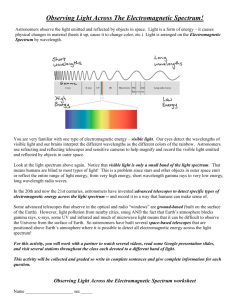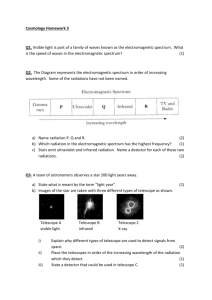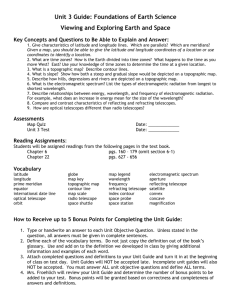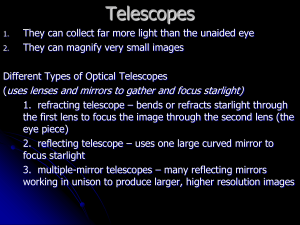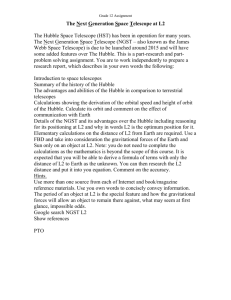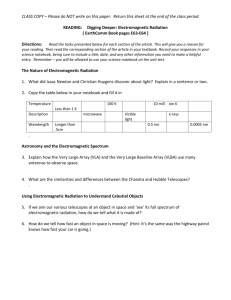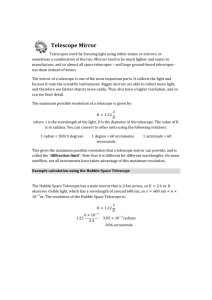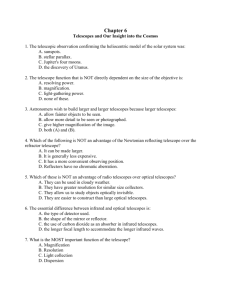Different colors of light are waves
advertisement
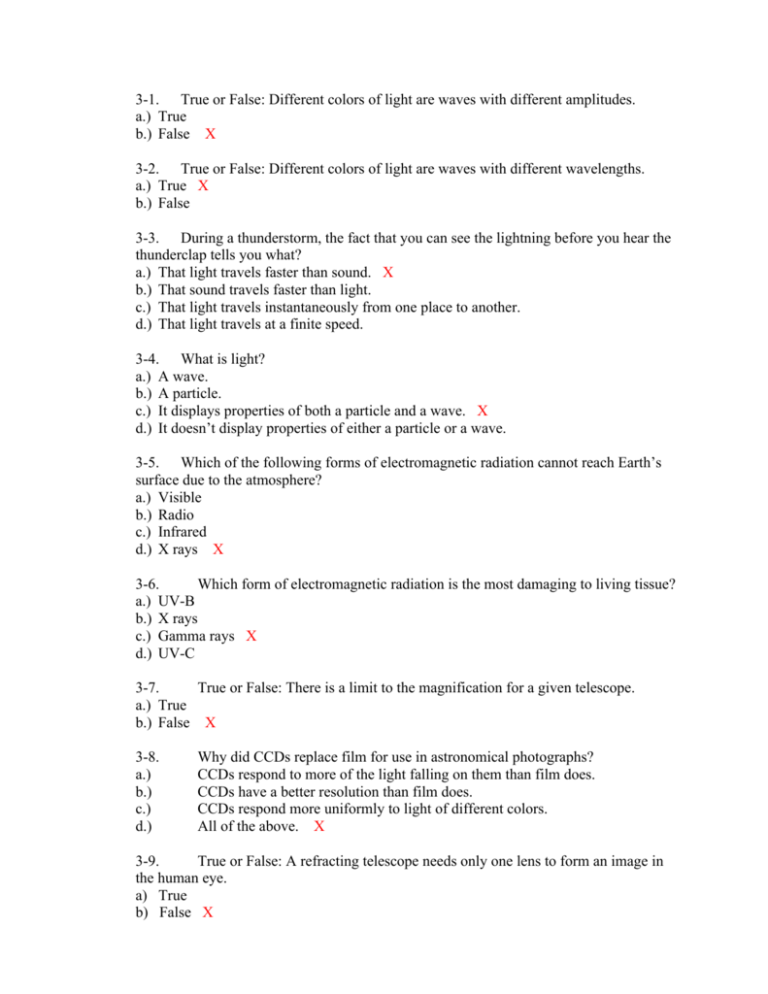
3-1. True or False: Different colors of light are waves with different amplitudes. a.) True b.) False X 3-2. True or False: Different colors of light are waves with different wavelengths. a.) True X b.) False 3-3. During a thunderstorm, the fact that you can see the lightning before you hear the thunderclap tells you what? a.) That light travels faster than sound. X b.) That sound travels faster than light. c.) That light travels instantaneously from one place to another. d.) That light travels at a finite speed. 3-4. What is light? a.) A wave. b.) A particle. c.) It displays properties of both a particle and a wave. X d.) It doesn’t display properties of either a particle or a wave. 3-5. Which of the following forms of electromagnetic radiation cannot reach Earth’s surface due to the atmosphere? a.) Visible b.) Radio c.) Infrared d.) X rays X 3-6. Which form of electromagnetic radiation is the most damaging to living tissue? a.) UV-B b.) X rays c.) Gamma rays X d.) UV-C 3-7. True or False: There is a limit to the magnification for a given telescope. a.) True b.) False X 3-8. a.) b.) c.) d.) Why did CCDs replace film for use in astronomical photographs? CCDs respond to more of the light falling on them than film does. CCDs have a better resolution than film does. CCDs respond more uniformly to light of different colors. All of the above. X 3-9. True or False: A refracting telescope needs only one lens to form an image in the human eye. a) True b) False X 3-10. The secondary mirror used in reflecting telescopes blocks some of the light entering the telescope from reflecting off the primary mirror. What effect does this have on the image produced? a.) The image will have a hole in the center. b.) The image will be dimmer than if no light was blocked. X c.) The image will be distorted due to lost information but this effect can be corrected. d.) The image cannot be magnified as much due to the lost light. 3-11. True or False: Refracting telescopes have more limitations than reflecting telescopes. a) True X b) False 3-12. a.) b.) c.) d.) What causes stars to appear to “twinkle”? Rapidly changing air density in the atmosphere. X Rapidly changing brightness of the stars. The Earth’s magnetic field interacting with the light. The limitations of the human eye. 3-13. a) b) c) d) Which type of telescope suffers from chromatic aberration? Cassegrain refractor X Coudé Newtonian 3-14. Which type of electromagnetic radiation has had an increasingly large “window” through our atmosphere over the past half century? a) gamma rays b) infrared radiation c) visible light d) ultraviolet X 3-15. The Hubble space telescope has which of the following advantages over landbased telescopes? Choose one. a) the light entering it is not distorted by the Earth's atmosphere X b) Hubble has the largest diameter of any telescope ever built c) there are no mirrors in Hubble to distort the light d) Hubble sees huge angular regions of the sky compared to any ground-based telescope 3-16. a) b) c) d) A telescope with which of the following diameters has the highest resolution? 4 cm 8 cm 12 cm X all of the above have the same resolution. 3-17. a) b) c) d) How long does it take light to travel 3 × 108 m? 1 year 8 minutes 1 minute 1 second X 3-18. a) b) c) d) The frequency of light is the number of wave crests passing a point per second. X another name for the speed of light. the number of oscillations per second of the electric and magnetic fields. a measure of the brightness of the light. 3-19. A light source has a frequency of 2 × 1013 Hz. What region of the electromagnetic spectrum is it in? a) Gamma ray b) Ultraviolet c) Visible d) Infrared X e) Microwave 3-20. a) b) c) d) 3-21. a) angle. b) c) d) A light source has a frequency of 2 × 105 Hz. What is its wavelength? 0.67 × 10−3 m 1.5 × 103 m X 6 × 1013 m 0.16 × 10−13 m When light is incident on a surface (see diagram), refraction occurs when it “bounces off” at an angle (measured form the normal) equal to the incident it enters the second medium and changes direction. X it enters the second medium and changes frequency. it “bounces off” and changes frequency. First medium light Second medium 3-22. to a) b) c) d) The primary purpose of building larger optical telescopes on the Earth’s surface is increase the light-gathering power. X increase the magnification. improve the resolution. allow a wider range of wavelengths to be viewed. 3-23. The focal length of the objective of a refractor telescope is 80 cm, and the focal length of the eyepiece is 8 cm. What is the magnification of the telescope? a) 80× b) 10× X c) 8× d) 2× 3-24. a) b) c) d) Chromatic aberration occurs when light passes through glass. X reflects off glass. reflects off a mirror. enters a telescope just before it reflects or refracts. 3-25. The two kinds of electromagnetic radiation that can easily be observed through the Earth’s atmosphere are a) visible (optical) and ultraviolet. b) visible (optical) and infrared. c) ultraviolet and infrared. d) visible (optical) and radio. X 3-26. a) b) c) d) An emission spectrum is best described by which of the following? All colors Only a few, separate colors X No colors at all All colors, except a few missing ones 3-27. a) b) c) d) A star's surface temperature is most accurately determined from: the number of planets orbiting it. its color. X its distance from Earth. its rotation rate. 3-28. a) b) c) d) The nucleus of an atom contains which of the following? protons and electrons neutrons and electrons just protons protons and neutrons X 3-29. We can determine the chemical composition of an object most accurately from which of the following? a) Its size b) How fast it is moving c) Its spectrum X d) The peak of its blackbody radiation 3-30. a) b) c) d) Isotopes of an atom have different numbers of: protons electrons neutrons X photons 3-31. a) b) c) d) A star with which color has the hottest surface? blue X red orange yellow 3-32. Which of the following objects emits an emission spectrum in which light is present only at certain wavelengths? a) The filament of a light bulb b) The surface of a star c) Light from a low-density nebula heated by a nearby star X d) None of the above 3-33. What type of spectrum is shown in the figure? a) b) c) d) Emission Absorption Reflection Continuous 3-34. a) b) c) d) A blackbody is a body that is black in color. absorbs all the light incident on it. reflects all the light incident on it. is a body at very low temperature. X X 3-35. The star Betelgeuse has a surface temperature of approximately 3500 K. At what wavelength does it emit most radiation? a) 10.1 m b) 1.2 × 106 m c) 8.3 × 10−7 m X d) 9.8 × 10−2 m 3-36. a) b) c) d) A source of light moves toward you. According to the Doppler effect the frequency of the light will increase. X frequency of the light will decrease. wavelength of the light will increase. the velocity of the light will increase. 3-37. Which set of lines in the diagram correspond to electron transitions that emit light in the visible range? a) Lyman series b) Balmer series X c) Paschen series d) None of them 3-38. Light has a particle nature, and these particles are called photons. Which region of the electromagnetic spectrum has the highest energy photons? a) b) c) d) e) gamma ray X-ray ultraviolet visible infrared X Thought/Writing Questions 3-39. Explain why a telescope with a larger diameter can provide the same brightness during a shorter exposure as a smaller telescope over a longer exposure 3-40. Explain twinkling. 3-41. If an isotope has a half-life of 300 years, after what length of time will ¾ of a sample decay? 3-42. Explain why proper motion occurs Misconception-Based Questions 3-43. Why don’t secondary mirrors create holes in images taken by reflecting telescopes? 3-44. Why don’t telescopes see things in the universe as they are now? 3-45. Explain why red-hot objects are the coolest glowing objects. 3-46. Since the Sun peaks in the blue-green part of the spectrum, why doesn’t it appear turquoise to us?

